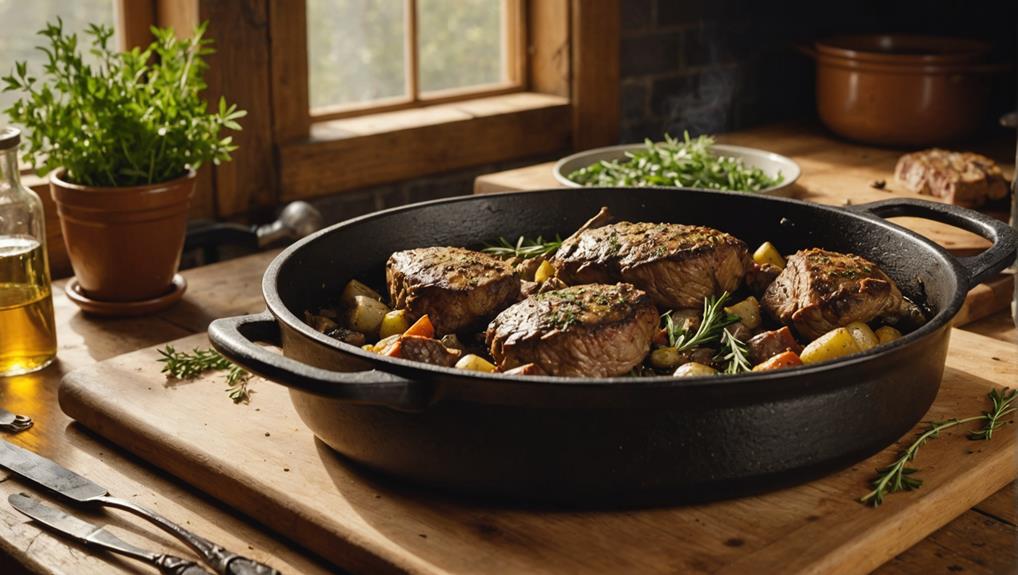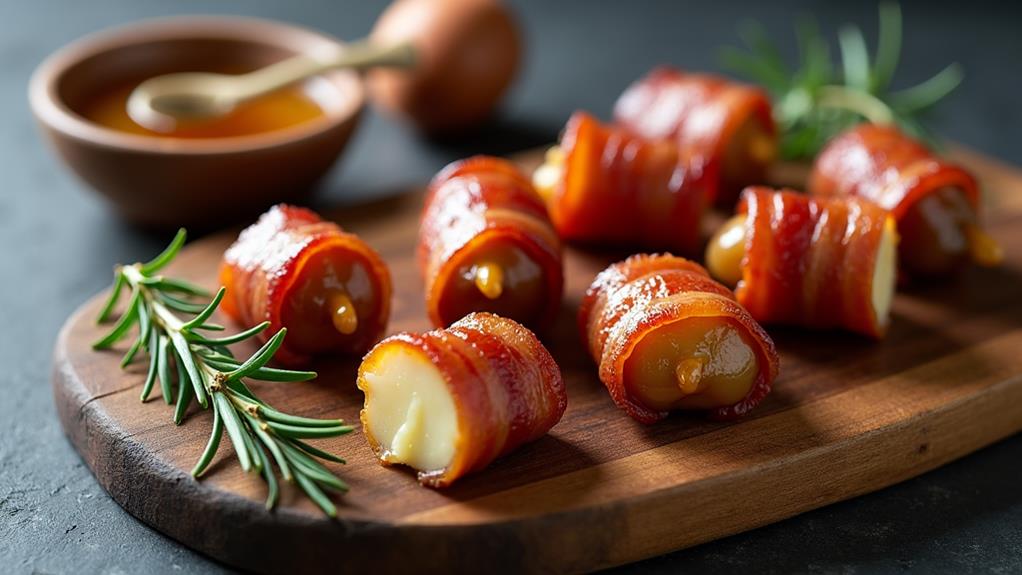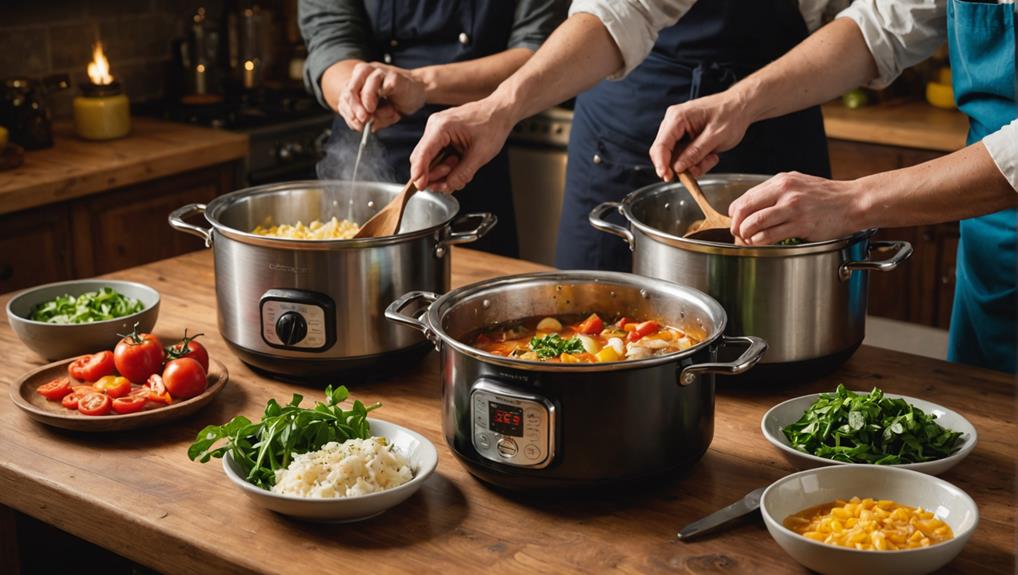Roasting and braising are culinary techniques that, when combined, create a symphony of flavors and textures in your dishes. By mastering these methods, you'll transform ordinary ingredients into extraordinary meals. Roasting utilizes high heat to develop a crispy exterior, while braising employs slow, moist cooking to enhance flavor and tenderness. Both techniques rely on the Maillard Reaction for rich flavors through caramelization. Essential tools include a heavy-duty roasting pan, Dutch oven, and quality meat thermometer. Select tough cuts like chuck or short ribs for braising, and well-seasoned chicken for roasting. Experiment with multi-ingredient rubs and fresh aromatics to build robust flavor profiles. The fusion of these techniques offers endless possibilities for culinary exploration.
Mastering Two Culinary Powerhouses
Culinary enthusiasts know that roasting and braising are two powerhouse techniques that can transform ordinary ingredients into extraordinary dishes.
These methods, while distinct, share a common goal: to create flavorful, tender meals that'll impress even the most discerning palates. For instance, when braising, incorporating hearty ingredients like root vegetables—such as carrots and potatoes—can enhance the dish's overall flavor and nutritional value, making it a wholesome offering.
Roasting harnesses high heat to achieve a crispy exterior and caramelized flavors, perfect for chicken and vegetables. You'll find that basting during the process helps maintain moisture and enhances taste.
Braising, on the other hand, combines both dry and moist heat techniques. It starts with browning ingredients in fat, then slowly cooking them in a flavorful liquid, often complemented by a rich hearty beef stew. This method is ideal for tougher cuts of meat, which become tender and succulent over time.
Both techniques rely on the Maillard Reaction to develop rich flavors through caramelization. When braising, you'll want to incorporate aromatic vegetables, herbs, and liquids like stock or wine to create a complex flavor profile.
While roasting often requires shorter cooking times, braising can extend up to 8 hours for optimal tenderness. By mastering these techniques, you'll elevate your culinary skills and create dishes that are sure to wow your guests.
Essential Tools and Equipment
To excel in roasting and braising, you'll need the right tools at your disposal. A heavy-duty roasting pan is essential for achieving even heat distribution during the roasting process, while a Dutch oven is your go-to vessel for the slow, moist cooking required in braising.
These two pieces of equipment form the foundation of your culinary arsenal.
Don't underestimate the importance of a quality meat thermometer. It's your secret weapon for ensuring meats are cooked to perfection, guaranteeing both safety and optimal flavor.
A sturdy wooden spoon or spatula is crucial for scraping up those flavorful bits, known as fond, during deglazing. This step is key to creating rich, complex sauces that elevate your dishes.
For precision in preparation, invest in kitchen shears. They'll prove invaluable for trimming meat and cutting herbs efficiently.
Lastly, a set of measuring cups and spoons is essential for accurately following recipes. By equipping yourself with these tools, you'll be ready to innovate in the kitchen, mastering the art of roasting and braising with confidence and creativity.
Selecting Prime Ingredients
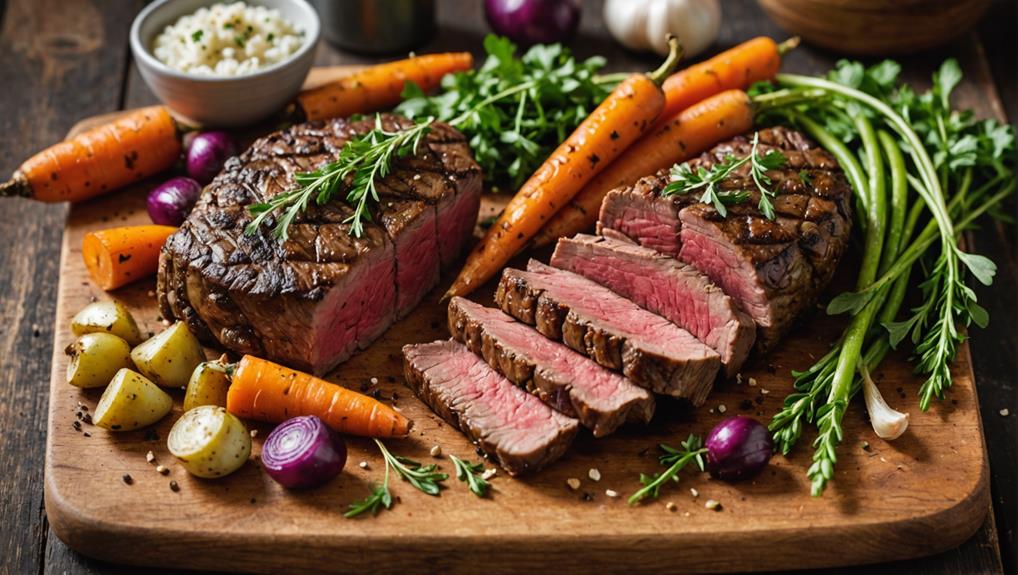
When it comes to roasting and braising, selecting prime ingredients is paramount to achieving exceptional results. For these slow-cooking methods, you'll want to focus on high-quality cuts of meat that can withstand extended cooking times while developing rich, complex flavors. Cuts like chuck, shank, or short ribs are especially suitable due to their marbling and connective tissue, making them ideal for methods like braised short ribs in red wine, which enhance flavor during the cooking process.
To elevate your dish, consider using a multi-ingredient rub that combines garlic powder, cumin, and paprika. This blend will enhance the depth of flavor in your chosen meats.
Don't forget to incorporate aromatics like onions, garlic, and herbs to build a robust flavor foundation and create a more complex braising liquid.
When selecting produce to accompany your roast or braise, choose fresh, quality vegetables. Carrots and apples, for instance, add essential sweetness and balance to savory flavors.
If you're roasting chicken, ensure it's well-seasoned and brined beforehand to maximize juiciness and flavor throughout the meat. By carefully selecting these prime ingredients, you'll set the stage for a truly exceptional culinary experience.
Perfecting the Roasting Technique
To elevate your roast chicken to new heights, you'll want to focus on two key aspects: seasoning and searing.
Start by creating a flavorful rub with garlic powder, cumin, brown sugar, paprika, chili flakes, and black pepper, allowing the chicken to marinate overnight for maximum flavor absorption.
An excellent alternative seasoning approach could be to use salt generously to ensure even seasoning, much like the technique in the Pea & Tarragon Cream Roast Chicken.
When it's time to roast, choose a high smoke point oil like canola or grapeseed, and sear the chicken at a medium-high temperature to achieve that perfect, caramelized exterior before lowering the heat for thorough cooking.
Seasoning for Maximum Flavor
Mastering the art of seasoning is essential for perfecting your roasting technique. To elevate your dish's flavor profile, start with the fundamentals: salt and pepper. These cornerstone ingredients amplify the meat's natural taste, laying a solid foundation for more complex seasoning.
For a truly innovative approach, create a multi-ingredient rub that combines garlic powder, cumin, brown sugar, paprika, chili flakes, and black pepper. This blend will introduce depth and complexity to your roast.
To maximize flavor distribution and moisture retention, allow your meat to marinate overnight with the seasoning. This extended period ensures that the flavors penetrate deeply, resulting in a more satisfying final product.
Don't underestimate the power of aromatic ingredients and proper timing in your marination process; these factors significantly contribute to the overall depth of flavor.
Mastering the Sear
A perfectly seared roast sets the stage for an exceptional meal. To brown the meat effectively, you'll want to use a braiser or Dutch oven over medium heat. Choose neutral oils like canola or grapeseed for their high smoke points, which prevent burning while creating that coveted caramelized crust.
The searing process isn't just about sealing in juices; it's a flavor-enhancing technique that harnesses the power of the Maillard Reaction. This chemical process not only improves taste but also provides a multi-textured eating experience.
Be cautious with your seasoning rub, though. Burning the sugar can lead to unpleasant flavors, so monitor the heat closely.
Once you've achieved that perfect sear, it's time to build layers of flavor. Add aromatics like garlic and onions to create a foundational taste profile.
Then, deglaze the pot with wine, stock, or vinegar. This crucial step releases those flavorful browned bits stuck to the bottom, forming the basis of a rich, complementary sauce.
Unlocking Braising's Flavor Potential
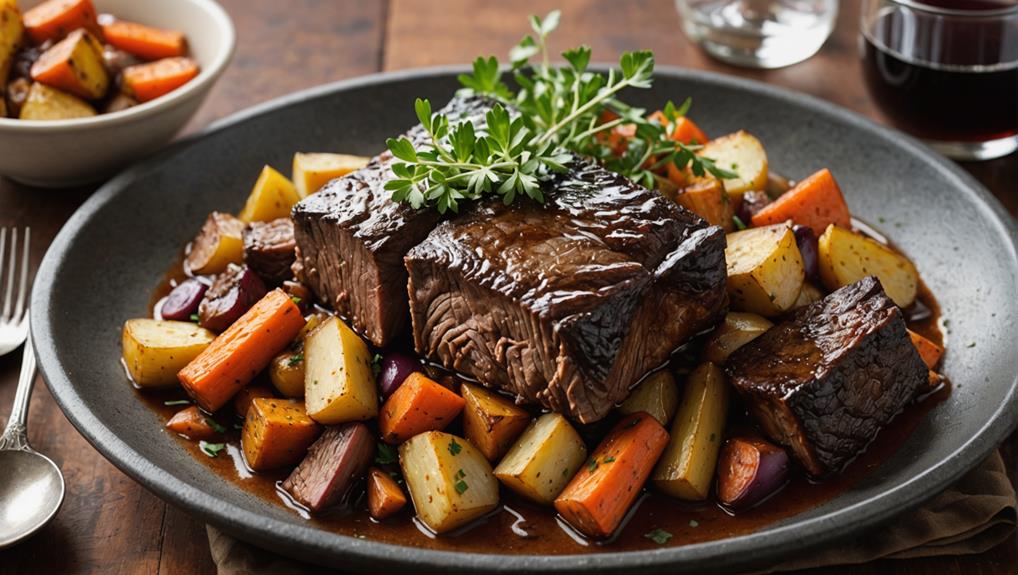
To unlock braising's flavor potential, you'll need to master the art of selecting aromatics and liquids that complement your chosen meat.
Start by perfecting the browning process, which is crucial for developing rich, complex flavors through the Maillard reaction.
When choosing cuts for braising, opt for tougher meats like chuck or short ribs, as they'll become tender and flavorful during the long, slow cooking process.
Aromatics and Liquid Selection
At the heart of every sumptuous braised dish lies a carefully chosen blend of aromatics and liquids. Your journey to culinary excellence begins with selecting the right foundational ingredients.
Aromatic vegetables like onions, garlic, and celery form the flavor base, enhancing your dish's depth and complexity. To elevate your braising game, incorporate a bouquet garni—a bundle of fresh herb stems that infuses your creation with subtle, nuanced flavors.
When it comes to the braising liquid, quality is paramount. Choose high-grade wine, stock, or juice to ensure a rich, flavorful result. For the ultimate depth, opt for homemade stock over store-bought varieties.
As you deglaze the pot, remember that those brown bits are flavor gold. Incorporate your chosen liquid to extract these concentrated essences, creating a cohesive sauce that ties the dish together.
Mastering the Browning Process
Building upon the foundation of carefully selected aromatics and liquids, the next key step in braising mastery lies in perfecting the browning process. This crucial phase unlocks a wealth of flavor potential through the Maillard Reaction, transforming your dish from ordinary to extraordinary.
You'll want to embrace this high-heat technique to develop rich, complex flavors that elevate your culinary creations. To achieve optimal browning, select a braiser or Dutch oven and use neutral oils like canola or grapeseed. These oils prevent burning, especially when you've applied sugar-containing rubs to your meat.
As you sear, you're not just caramelizing the exterior for improved texture; you're also creating the foundation for a luxurious sauce. The brown bits, known as fond, will later be deglazed, infusing your braising liquid with intense flavor.
Don't be tempted to skip this step, even if it seems time-consuming. The investment you make in browning pays off handsomely in the final product.
You'll be rewarded with a multi-dimensional flavor profile that tantalizes the taste buds and showcases your culinary expertise.
Ideal Cuts for Braising
When it comes to unlocking braising's flavor potential, selecting the right cuts of meat is paramount. You'll want to focus on tougher, connective-tissue-rich options like shank, short rib, and chuck.
These cuts benefit immensely from slow cooking, transforming into tender, flavorful dishes that'll impress even the most discerning palates.
Don't limit yourself to beef, though. Lamb shanks and veal shoulder are excellent choices, as are poultry parts like thighs and legs.
The key is to choose larger cuts that can withstand long cooking times, typically two to four hours. This extended process allows flavors to develop fully and ensures optimal tenderness.
Braising isn't just a cooking method; it's an opportunity for culinary innovation. As you experiment with different cuts of meat, consider how you can adapt your techniques to various ingredients and flavor profiles.
Remember, the ideal cuts should maintain moisture and flavor throughout the cooking process.
While braising is perfect for cold weather comfort food, don't be afraid to push boundaries.
Try incorporating unexpected ingredients or global flavors to create unique, satisfying dishes that'll elevate your culinary repertoire year-round.
Marrying Roasting and Braising
The culinary world often presents techniques as distinct entities, but marrying roasting and braising creates a powerhouse method that combines the best of both worlds.
You'll start by roasting your meat at high heat, developing rich flavors through caramelization. This initial step is crucial for building depth and complexity in your dish.
Once you've achieved that perfect sear, you'll transition to braising. Transfer your meat to a flavorful liquid and reduce the temperature to around 300°F. This slow cooking process will tenderize even the toughest cuts, infusing them with succulent softness.
Don't forget to leverage the fond created during roasting. Deglaze your roasting pan and incorporate those flavorful bits into your braising liquid. Add essential aromatics like garlic and onions to build a robust flavor base.
This fusion technique allows you to experiment with various approaches. You might sear the meat in the oven before adding it to your braising liquid, or you could start with a stovetop sear.
Whichever method you choose, you'll achieve a perfect balance of juicy, caramelized texture and melt-in-your-mouth tenderness.
Timing: The Secret Ingredient
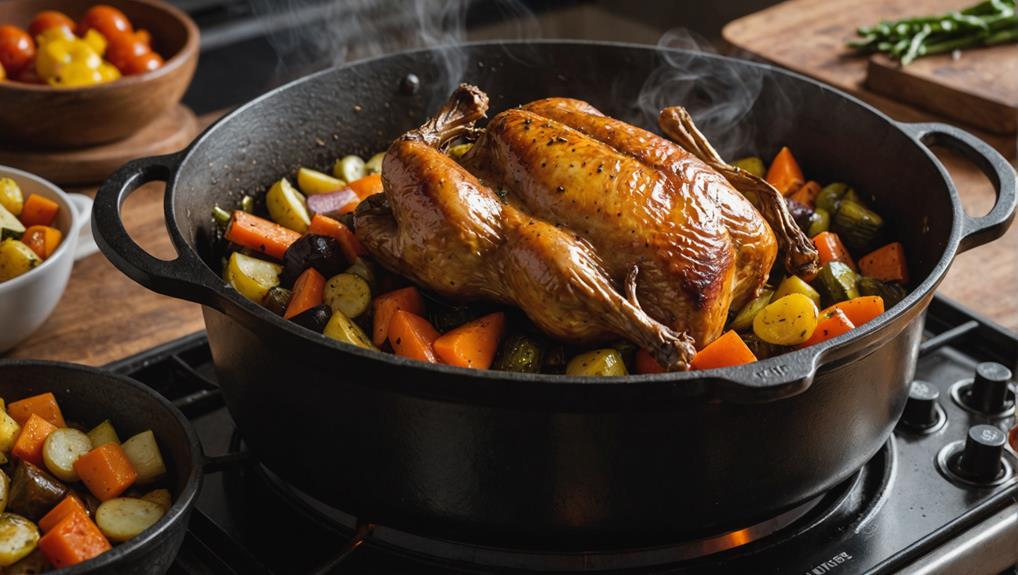
In the realm of culinary mastery, timing reigns supreme as the unsung hero of roasting and braising. When roasting chicken, adhere to the 20-minute-per-pound rule at 375°F for optimal tenderness and flavor infusion.
Braising, however, demands a more nuanced approach. Tougher cuts might require up to 8 hours, while chicken thighs can reach perfection in just 45 minutes.
To elevate your braising game, monitor liquid levels closely. Aim for one-third meat coverage to maintain moisture and prevent drying. Before you begin, sear the meat over medium heat to unlock deep flavors through the Maillard reaction. This crucial step sets the stage for a richer, more complex dish.
Don't overlook the importance of resting time. After roasting, allow your meat to rest for 15-20 minutes. This pause enables juices to redistribute, enhancing overall flavor and moisture.
Flavor-Enhancing Tips and Tricks
Building on the importance of timing, let's explore the art of flavor enhancement in roasting and braising. To elevate your dishes, start by seasoning with a multi-ingredient rub. Combine garlic powder, cumin, brown sugar, paprika, chili flakes, and black pepper for a flavorful crust that'll tantalize taste buds.
Next, sear your meat at medium heat in a braiser or Dutch oven using neutral oils like canola or grapeseed. This crucial step locks in juices and caramelizes the exterior, improving both texture and visual appeal.
Don't overlook the power of aromatics. Incorporate garlic, onions, and fresh herbs to build foundational flavor and enrich your braising liquid. After searing, deglaze the pan with stock, wine, or vinegar to extract those rich, browned bits that'll enhance your sauce's depth and coherence.
As you braise, maintain liquid levels about one-third up the meat and keep the cooking temperature around 300°F for slow, tender results. These techniques will transform your roasts and braises, creating complex, mouthwatering dishes that'll impress even the most discerning palates.
Presentation and Serving Suggestions

Presentation transforms a well-cooked dish into a memorable dining experience. To elevate your fusion creations, consider the visual impact of your serving suggestions. Start by using varying plate sizes to create an interesting landscape on the table. Incorporate vibrant seasonal vegetables to add pops of color that'll entice your diners' eyes and appetites.
When plating, think about balance. Arrange components to showcase the interplay of flavors – sweetness, acidity, and richness. This thoughtful presentation will heighten the family dining experience.
Don't forget to garnish! Fresh ingredients like grated parmesan, basil, cilantro, scallions, or pickled mustard greens can enhance both visual appeal and flavor profiles.
For broth-based meals, consider serving in multi-use vessels that engage family members and promote creative ingredient usage. This approach adds comfort and tradition to your table.
Remember, texture is crucial in presentation. For dishes like roasted chicken, pair with al dente spaghetti tossed in sauce for a delightful bite.
Frequently Asked Questions
What Is the Difference Between Brazing and Roasting?
You'll notice a texture contrast between braising and roasting. Braising combines dry and moist heat, creating tender, juicy results. Roasting uses dry heat alone, yielding crispy exteriors. Both techniques offer unique flavor profiles for culinary innovation.
What Is Brazing Your Meat?
Did you know braising can reduce cooking time by up to 50%? You're using innovative Braising Techniques when you sear your meat, then slow-cook it in liquid. It's a game-changing method that transforms tough cuts into tender, flavorful dishes.
What Does Braising Mean in Cooking?
When you're braising, you're unlocking complex flavor profiles through a two-step cooking process. You'll first sear your meat, then slow-cook it in liquid. This innovative technique transforms tough cuts into tender, richly flavored dishes you'll love.
What Is the Best Meat for Braising?
You'll want to choose tough, collagen-rich meat cuts for braising. Go for chuck, short rib, or shank. Don't overlook lamb or veal for a twist. Even dark meat poultry works well. Experiment with these options for innovative, tender results.
Final Thoughts
You've now explored the savory secrets of roasting and braising, unlocking a world of culinary possibilities. By mastering these techniques and combining them, you'll elevate your cooking to new heights. Remember, the true magic lies in your willingness to experiment and refine your skills. As you apply these methods, you'll discover that the theory of flavor fusion isn't just true—it's transformative. Your kitchen will become a playground of tastes, textures, and aromas, delighting both you and your guests.

